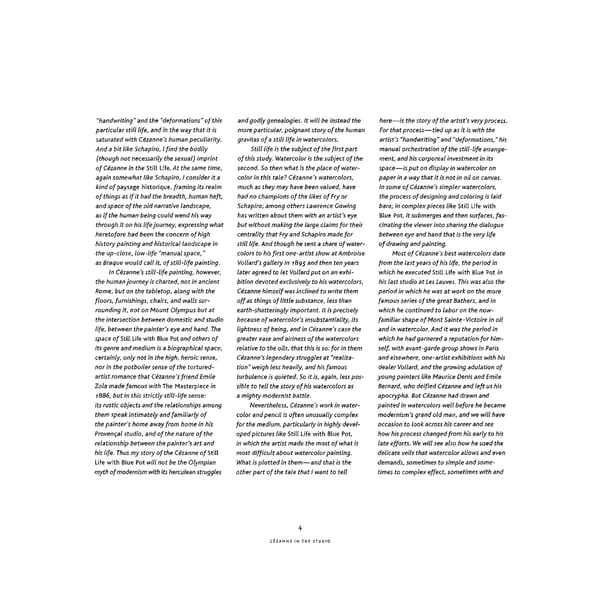"handwriting" and the "deformations" of this and godly genealogies. It will be instead the here—is the story of the artist's very process. particular still life, and in the way that it is more particular, poignant story of the human For that process—tied up as it is with the saturated with Cezanne's human peculiarity. gravitas of a still life in watercolors. artist's "handwriting"and "deformations,"his And a bit like Schapiro, I find the bodily Still life is the subject of the first part manual orchestration of the still-life arrange- (though not necessarily the sexual) imprint of this study. Watercolor is the subject of the ment, and his corporeal investment in its of Cezanne in the Still Life. At the same time, second. So then what is the place of water- space—is put on display in watercolor on again somewhat like Schapiro, I consider it a color in this tale? Cezanne's watercolors, paper in a way that it is not in oil on canvas. kind o/paysage historique, framing its realm much as they may have been valued, have In some of Cezanne's simpler watercolors, of things as if it had the breadth, human heft, had no champions of the likes of Fry or the process of designing and coloring is laid and space of the old narrative landscape, Schapiro; among others Lawrence Cowing bare; in complex pieces like Still Life with as if the human being could wend his way has written about them with an artist's eye Blue Pot it submerges and then surfaces, fas- through it on his life journey, expressing what but without making the large claims for their cinating the viewer into sharing the dialogue heretofore had been the concern of high centrality that Fry and Schapiro made for between eye and hand that is the very life history painting and historical landscape in still life. And though he sent a share of water- of drawing and painting. the up-close, low-life "manualspace," colors to his first one-artist show atAmbroise Most of Cezanne's best watercolors date as Braque would call it, of still-life painting. Vollard's gallery in 7895 and then ten years from the last years of his life, the period in In Cezanne's still-life painting, however, later agreed to let Vollard put on an exhi- which he executed Still Life with Blue Pot in the human journey is charted, not in ancient bition devoted exclusively to his watercolors, his last studio at Les Lauves. This was also the Rome, but on the tabletop, along with the Cezanne himself was inclined to write them period in which he was at work on the more floors, furnishings, chairs, and walls sur- off as things of little substance, less than famous series of the great Bathers, and in rounding it, not on Mount Olympus but at earth-shatteringly important. It is precisely which he continued to labor on the now- the intersection between domestic and studio because ofwatercolor's insubstantiality, its familiar shape of Mont Sainte-Victoire in oil life, between the painter's eye and hand. The lightness of being, and in Cezanne's case the and in watercolor. And it was the period in space of Still Life with Blue Pot and others of greater ease and airiness of the watercolors which he had garnered a reputation for him- its genre and medium is a biographical space, relative to the oils, that this is so: for in them self, with avant-garde group shows in Paris certainly, only not in the high, heroic sense, Cezanne's legendary struggles at "realiza- and elsewhere, one-artist exhibitions with his nor in the potboiler sense of the tortured- tion" weigh less heavily, and his famous dealer Vollard, and the growing adulation of artist romance that Cezanne's friend Emile turbulence is quieted. So it is, again, less pos- young painters like Maurice Denis and Emile Zola made famous with The Masterpiece in sible to tell the story of his watercolors as Bernard, who deified Cezanne and left us his 1886, but in this strictly still-life sense: a mighty modernist battle. apocrypha. But Cezanne had drawn and its rustic objects and the relationships among Nevertheless, Cezanne's work in water- painted in watercolors well before he became them speak intimately and familiarly of color and pencil is often unusually complex modernism's grand old man, and we will have the painter's home away from home in his for the medium, particularly in highly devel- occasion to look across his career and see Provencal studio, and of the nature of the oped pictures like Still Life with Blue Pot how his process changed from his early to his relationship between the painter's art and in which the artist made the most of what is late efforts. We will see also how he used the his life. Thus my story of the Cezanne of Still most difficult about watercolor painting. delicate veils that watercolor allows and even Life with Blue Pot will not be the Olympian What is plotted in them—and that is the demands, sometimes to simple and some- myth of modernism with its herculean struggles other part of the tale that I want to tell times to complex effect, sometimes with and 4 CEZANNE IN THE STUDIO
 Cézanne in the Studio: Still Life in Watercolors Page 18 Page 20
Cézanne in the Studio: Still Life in Watercolors Page 18 Page 20